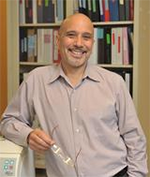
Northwestern Medicine scientists have revealed a new role for a protein in Legionella pneumophila, a bacteria that replicates in amoebae in natural and manmade water systems, causing Legionnaires’ disease.
In a paper published in Infection and Immunity, they demonstrated that this protein, Cas2, has nucleus activity, or the ability to cleave the bonds between nucleic acids including RNA and DNA.
“We think this protein is modifying bacterial RNA expression so that L. pneumophila virulence toward amoebae is expressed more effectively,” said Nicholas Cianciotto, PhD, professor in Microbiology-Immunology.
Previously, Cianciotto and his co-authors had showed in a paper published in mBio that the Cas2 protein promotes Legionella infection of different species of amoebae. In addition to providing a place to grow and replicate, the amoebae host can protect the bacteria from biocides that would normally kill the organism.
“The bacteria become amplified by growing in the amoebae and as a result, are more likely to be aerosolized and inhaled by us,” Cianciotto said. “Amoebae are important in the transmission of the disease-causing bacteria from the environment to the human host, so the fact that this protein promotes infection of amoebae by L. pneumophila is quite significant in terms of understanding the genesis of disease.”
In this study, the Cianciotto lab created different forms of Cas2 and compared them to identify the active part of the protein. They then mutated Cas2 in the Legionella bacteria and found the mutant bacteria had a diminished ability to infect the amoebae.
Taking this research one step further, Cianciotto and his co-authors inserted the gene that codes for Cas2 into a strain of L. pneumophila that naturally lacks the gene and discovered that it caused the strain to become more infectious for amoebae.

“This suggests that in the natural environment, there is a selective advantage for strains to acquire this gene and to retain it,” he said.
Cianciotto said the paper not only defines a new virulence component of the Legionella bacterium but also provides insight into how the Cas family of proteins function and work in a larger system, called CRISPR-Cas. This system has previously been described as providing bacteria with immunity against phages – viruses that infect bacteria – but the study shows that proteins in the CRISPR-Cas system have other responsibilities, as well.
“We have this idea that bacteria evolved the CRISPR-Cas system for phage immunity, but parts of this system can do other things. It is a real documentation of the way bacteria are very effective at using their small genomes to do many different things,” he said.
Cianciotto thinks these studies will prompt similar studies with other bacterial species and that further research on the enzymology of Cas2 proteins is needed.
In ongoing research, Cianciotto is collaborating with Wayne F. Anderson, PhD, professor in Biochemistry and Molecular Genetics, to determine the structure of L. pneumophila Cas2 and compare it to other proteins to discover any unique structural attributes.
Other futures studies will include finding the target(s) for the Cas2 activity in L. pneumophila and learning why the Cas2 mutant doesn’t grow well in the amoebae.
Finally, Cianciotto noted that this area of research serves as a reminder of how systems in primitive bacteria can have wider implications and applications. Indeed, another nuclease component of the CRISPR-Cas systems, Cas9, is being widely utilized in a new form of genomic engineering.
In addition to Cianciotto, this study was performed by post-doctoral fellow Felizza Gunderson and Driskill Graduate Program in Life Sciences students Celeste Mallama and Stephanie Fairbairn.
This research was funded by the National Institutes of Health grant R21AI103451.






